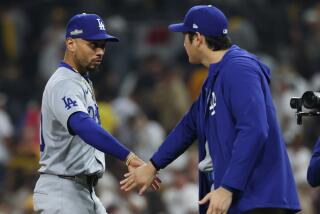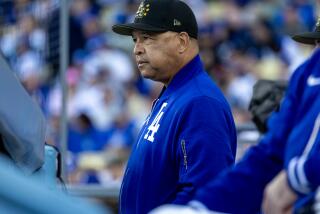Seattle General Manager Has Business Down Pat
- Share via
Pat Gillick has too much going for him as general manager of the runaway Seattle Mariners, too much going for him as a man who has produced winners at each of his GM stops, to look back and dwell on one that got away.
Only observers familiar with a little-known piece of Angel history are left to wonder how Gillick might have transformed that beleaguered franchise if a group he fronted had purchased the team before Gene and Jackie Autry sold to Disney.
After all, Gillick’s Toronto Blue Jays won five American League East titles and back-to-back World Series titles, his Baltimore Orioles reached the American League championship series in two of his three years there and his Mariners are on a fast track to a second consecutive playoff appearance despite the loss of Ken Griffey Jr. in his first winter on the job and Alex Rodriguez in his second.
As Brian Cashman, a man familiar with winning as general manager of the New York Yankees, said: “In our business, Pat Gillick is basically the architect of all architects. He wins everywhere he goes under just about every condition. Nothing he does surprises me any more given his success.”
A graduate of the old school, Gillick, 63, has adapted to the big-money pressure that recently has made the general manager’s office the domain of younger men and created volatile turnover in a job where there was seldom any.
“I always expect the seat I’m on to be a hot one, and I always try to be optimistic but realistic,” Gillick said. “Sometimes you can be so optimistic that it clouds your judgment. If you had asked me what I expected of our team coming out of spring training, I’d have probably said, ‘Maybe a few games over .500.’ I thought we’d have problems scoring runs. I was wrong. Now we’re quite a few over.”
It’s still June, the Mariners are 36 over and--despite recent vulnerability and the ongoing pursuit of another hitter (Chuck Knoblauch?) or pitcher--have all but won the West as they continue a three-game series against the Angels in Anaheim. This is where Gillick, a homeboy who graduated from USC at 20, had hoped to set up residency when he and a group that included Bill DeWitt Jr., now a principal owner of the St. Louis Cardinals, met with Jackie Autry about buying the Angels in the fall of 1995.
“I thought the Angels represented a good situation and still do, but I don’t think much about it any more or how anything might have been different,” Gillick said. “We had serious interest, but at the time she and Gene seemed to be too far [into negotiations] with Peter Ueberroth to change directions. I didn’t know what happened, but it was my impression the Autrys wanted to sell to a baseball-oriented person. I was surprised when they went with Disney and the marketing glitz.”
There hasn’t been much glitz, but that’s another story.
Any synopsis of the Gillick story should include that he was a pitcher on USC’s national-title team in 1958, spent five years pitching in the Baltimore farm system before accepting a front-office job with Houston, moved up through the farm and scouting ranks to become the Toronto general manager in 1977. He would shake a reputation as Stand Pat, a man reluctant to trade, and successfully turn that expansion team into one that dominated the East. Gillick retired after the 1994 season, a year after the Blue Jays had won back-to-back World Series titles--his blockbuster trade with San Diego for Joe Carter and Roberto Alomar providing the stimulus.
Retirement meant retirement. Gillick’s wife owned an art gallery in Toronto and he was making good money as a Blue Jay consultant. He insists he wasn’t looking for another job, but the prospect of running the Angels produced an itch too strong to ignore. It was not long after the Angel talks collapsed that he agreed to a three-year contract as general manager of the Orioles, lured essentially by the lobbying of Davey Johnson, a former minor league teammate who had already been hired by owner Peter Angelos as Oriole manager.
It looked like an ideal situation: a proven general manager and an owner who hated the Yankees and was willing to spend to beat them. The problem, however, was that the owner also thought he was the general manager, interfering in virtually every decision, charting his own course.
“The first year I became general manager in Toronto our entire payroll was $750,000,” Gillick said. “It’s a lot different now when millions of dollars are at stake. Ownership is much more involved, and I understand that. I’ve always said that the owner has the right to his decisions, but I also believe that you have to give the general manager some latitude within the financial parameters and you have to respect his experience and evaluation when it comes to personnel decisions. Mr. Angelos wanted to run the club his way. I could accept the fact that he was going to make all the decisions or I could leave, and that’s what I did.”
Johnson was fired by Angelos in his third year as manager. Gillick resigned when his contract expired. Angelos has since spent more for less than any owner in baseball. Gillick, after a year as chairman of the U.S. Pan American baseball team, accepted a three-year contract to replace Woody Woodward as general manager of the Mariners, stepping into a tenuous situation in which Woodward had already traded Randy Johnson under duress and Griffey and Rodriguez were coming up to free agency and one or both might have to be traded.
“I was aware of the situation generally,” he said. “I wasn’t aware that Griffey was so adamant about wanting to leave. I thought we could persuade him otherwise, but that wasn’t the case. I also thought we had a competitive shot to keep A-Rod, but I wasn’t aware that Texas would offer the ranch.
“I think the real reason they both left [Griffey via trade, Rodriguez via free agency] is that they were psyched out by [Safeco Field]. I think they wanted to win but had personal goals they didn’t think they could achieve in the new park. That was their big push. Now we have a second baseman [Bret Boone] who has hit 20 homers and we’re fifth in the league in home runs. Safeco isn’t the cracker box that a lot of the new parks are, but it’s obviously fair for both hitters and pitchers.”
The move to Safeco convinced Gillick and Manager Lou Piniella they would have to reshape the Mariners from the homer-happy, station-to-station team of the Kingdome to one that relies more on pitching, speed and defense.
Woodward provided a foundation by trading Johnson midseason in 1999, acquiring Freddy Garcia and John Halama, both key members of the Seattle rotation before the struggling Halama was optioned to triple A Thursday, and infielder Carlos Guillen, the 2001 replacement for Rodriguez at shortstop.
Gillick arrived in October ’99 and found Piniella’s wish list on his desk: improved bullpen, more left-handed hitting, better bench, one more starting pitcher.
Seldom does a manager get everything he wants, but Gillick aggressively provided it by signing six free agents: first baseman and left-handed hitter John Olerud, closer Kazuhiro Sasaki, left-handed set-up man Arthur Rhodes, starter Aaron Sele and versatile utility players Mark McLemore and Stan Javier. He also did the best he could under the duress of trading Griffey, acquiring center fielder Mike Cameron in a four-player package.
The Mariners won the wild card with a 91-71 record last year, beat the Chicago White Sox in the division series and lost to the Yankees in the ALCS. They then lost Rodriguez to Texas and bowed out of the high-stakes negotiations for Manny Ramirez before Gillick went another direction in trying to strengthen the offense--signing Boone, importing Ichiro Suzuki and boosting an already strong bullpen with the signing of Jeff Nelson.
The Mariners came to Anaheim having lost consecutive series for the first time this year, but their pace still projected to a major-league record 118 wins, or as Gillick said:
“How could anyone have envisioned this? I mean, if the Yankees are the yardstick, they won 87 games last year. We’ve simply had a lot things fall into place.”
Winning, of course, is infectious, and the Mariners tend to feed off one another. Gillick suggests that the difference between 91 wins and a projected 118 has been the catalytic influence of Suzuki and Boone.
“I’d have been happy if Ichiro batted .280 to .300 and Boone put up decent numbers with good defense,” Gillick said. “Now Ichiro leads the league in hitting and Boone leads in RBIs. They have far exceeded expectations. I’m not that good.”
Many would disagree with that, but Gillick said it all comes down to good scouting.
“You pinpoint needs and give scouts enough lead time to make evaluations,” said Gillick, who keeps his staff on the same page with a weekly conference call.
Gillick, an acknowledged workaholic, also does a lot of the inspecting himself.
The decision to make Michael Garciaparra, Nomar’s brother, the top Seattle selection in the recent amateur draft came only after Gillick flew in to watch a workout. He also traveled to meet personally with most of the free agents the Mariners have signed in the last two years.
“In any business, and certainly the baseball business, the winners and losers are separated by good instincts and good judgment,” club President Chuck Armstrong said, “and that’s what Pat brings beyond the hard work and integrity.”
Those instincts, Gillick said, have convinced him that “the more years I’m in it, the more important I think character is, particularly since the money has become so big. It used to be that you could tell a guy making forty grand to take a hike. Now you’ve got a guy making $20 million on a guaranteed five-year contract and you don’t like the way he’s acting? Well, there’s not much you can do about it.
“I mean, you better know the guy you’re signing, what you’re getting. We’ve had a remarkable start, and I definitely believe character is an important part of it.”
It also doesn’t hurt to have a supportive ownership--financial and otherwise. The money the Mariners saved on Rodriguez and Griffey could have been channeled toward the Safeco debt or the engineering of another Nintendo game.
Instead, the Mariners have a $78-million payroll that ranks 11th among the 30 teams and are doing better business than the coffee houses. They lead the league in attendance, are sold out for the rest of the year and are more secure in Seattle than Boeing, an improbability 10 years ago.
In addition, Gillick has the financial latitude to pursue a player who might make a difference in October.
Of course, they wouldn’t be planning for October in June if the general manager who had wanted to do it for the Angels hadn’t already made a difference for the Mariners.
More to Read
Go beyond the scoreboard
Get the latest on L.A.'s teams in the daily Sports Report newsletter.
You may occasionally receive promotional content from the Los Angeles Times.










